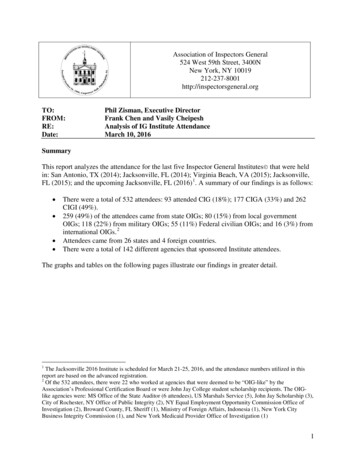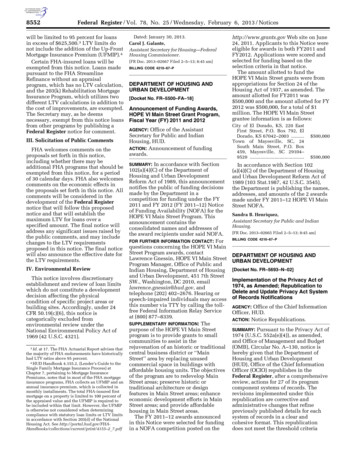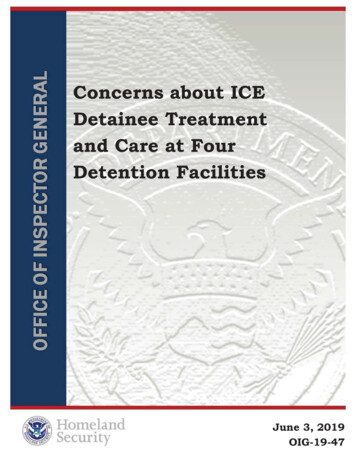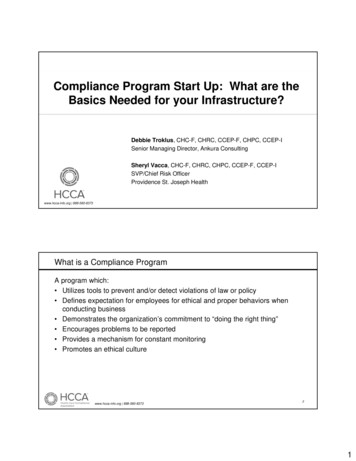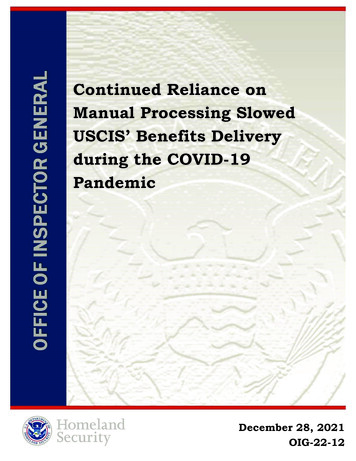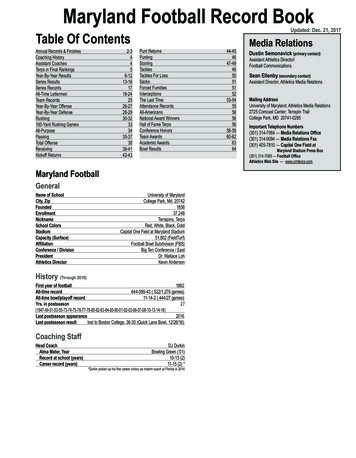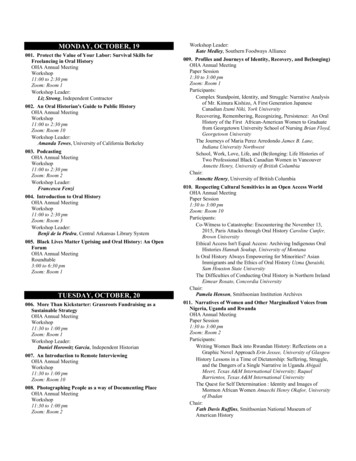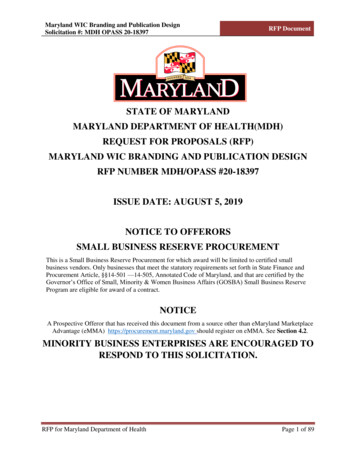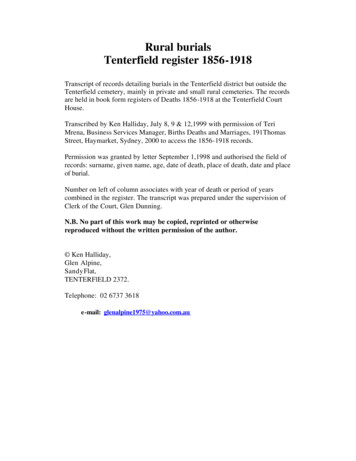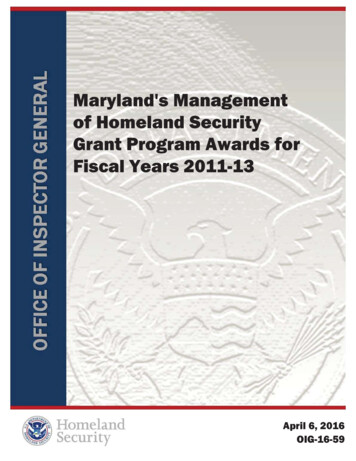
Transcription
Maryland's Managementof Homeland SecurityGrant Program Awards forFiscal Years 2011-13April 6, 2016OIG-16-59
DHS OIG HIGHLIGHTSMaryland’s Management of Homeland SecurityGrant Program Awards for Fiscal Years 2011–13April 6, 2016What We FoundWhy We DidThis AuditIn most instances, Maryland distributed andspent the HSGP awards in compliance withapplicable laws and regulations; however, theState lacked adequate controls over more than 10.8 million in grant funds we reviewed. Thisoccurred because FEMA and the State did notensure adequate management and oversight ofHSGP funds. Specifically, FEMA and Marylandneed to improve the following areas:Public Law 110-53, ImplementingRecommendations of the 9/11Commission Act of 2007, requiresthe Department of HomelandSecurity (DHS) Office of InspectorGeneral (OIG) to audit individualstates’ management of HomelandSecurity Grant Program (HSGP)awards. We audited the State ofMaryland, which was awarded 35 million from the FederalEmergency Management Agency(FEMA) for fiscal years 2011–13.What WeRecommendWe recommend that FEMA andMaryland ensure compliance withFederal requirements for propertymanagement, procurement, thetimely distribution of funds, andtracking costs. Actions includedeveloping a monitoring plan andprocedures, streamlining itsapplication and award process,and implementing a system totrack Management andAdministration costs. Subgrantee Monitoring,Property Management,Subgrantee Procurement,Obligations to Subgrantees, andManagement and Administration Costs.Improvements in these areas will enhanceMaryland’s effectiveness in the overall use ofthe grant funds to improve preparedness andresponse capabilities. Better management andoversight will also reduce the risk associatedwith the State’s management of FEMA grantfunds, such as property misuse, loss, damage,or theft.FEMA and Maryland’sResponseFEMA appreciated the OIG’s work andconcurred with all five recommendations.For Further Information:Contact our Office of Public Affairs at(202) 254-4100, or email us hs.govOIG-16-59
OFFICE OF INSPECTOR GENERALDepartment of Homeland SecurityWashington, DC 20528 / www.oig.dhs.govAPR 6 2016MEMORANDUM FOR:Brian E. KamoieAssistant Administrator forGrant ProgramsFederal Emergency Management AgencyFROM:Mark Bell ,/ Assistant Inspector General for AuditsSUBJECT:Maryland's Management ofHomeland Security GrantProgram Awardsfor Fiscal Years 2011-13Attached for your action is our final report, Maryland's Management ofHomeland Security Grant Program Awardsfor Fiscal Years 2011-13. Weincorporated the formal comments provided by your office.The report contains five recommendations identifying action FEMA can take toenhance Maryland's effectiveness in the overall use of the grant funds toimprove preparedness and response capabilities. Your office concurred with allfive recommendations. Based on information provided in your response to thedraft report, we consider recommendations 1 through 5 open and resolved.Once your office has fully implemented the recommendations, please submit aformal closeout letter to us within 30 days so that we may close therecommendations. The memorandum should be accompanied by evidence ofcompletion of agreed-upon corrective actions and of the disposition of anymonetary amounts. Please send your response or closure request toOIGAuditsFollowutXa,oi .dhs.Gov.Consistent with our responsibility under the Inspector General Act, we willprovide copies of our report to congressional committees with oversight andappropriation responsibility over the Department of Homeland Security. We willpost the report on our website for public dissemination.Please call me with any questions, or your staff may contact Don Bumgardner,Deputy Assistant Inspector General for Audits, at (202) 254-4100.Attachment
OFFICE OF INSPECTOR GENERALDepartment of Homeland SecurityTable of ContentsBackground . 1Results of Audit . 2Subgrantee Monitoring . 2Obligations to Subgrantees . 6Management and Administration Costs. 7Recommendations. xAppendixA:B:C:D:E:F:Objective, Scope, and Methodology . 12FEMA and Maryland Comments to the Draft Report. 14Competitive Procurement Transactions Questioned. 21Potential Monetary Benefits . 22Homeland Security Grant Program. 23DHS OIG Report OIG-10-116 Recommendations andResolutions. 24Appendix G: Office of Audits Major Contributors to This Report . 27Appendix H: Report Distribution. SIwww.oig.dhs.govCode of Federal RegulationsDepartment of Homeland Securityestimated completion dateFederal Emergency Management Agencyfiscal yearHomeland Security Grant ProgramManagement and AdministrationMaryland Emergency Management AgencyOffice of Inspector GeneralState Homeland Security ProgramUrban Areas Security InitiativeOIG-16-59
OFFICE OF INSPECTOR GENERALDepartment of Homeland SecurityBackgroundThe Department of Homeland Security (DHS) provides Federal funding throughthe Homeland Security Grant Program (HSGP) to assist state and local agencieswith capabilities to prevent, prepare for, protect against, and respond to acts ofterrorism, major disasters, and other emergencies. Within DHS, the FederalEmergency Management Agency (FEMA) is responsible for administering theHSGP. The State Homeland Security Program (SHSP) and the Urban AreasSecurity Initiative (UASI) are part of the HSGP and fund a wide range ofpreparedness activities such as planning, organization, equipment purchases,training, and exercises. Appendix E provides more information about HSGP.HSGP guidance requires a state administrative agency to administer andmanage grant funding awarded under HSGP. The Maryland EmergencyManagement Agency (MEMA) is the state administrative agency for Maryland’sHSGP. As such, MEMA is responsible for managing the SHSP and UASI grantsin accordance with established Federal guidelines and regulations. MEMAreceived SHSP grant funds for the State, as well as UASI grant funds for theBaltimore urban area. MEMA distributes the grant funds through sub-awardsto municipalities, counties, and state agencies.As illustrated in figure 1, during fiscal years (FY) 2011–13, FEMA awardedMEMA approximately 16 million, 9 million, and 11 million, respectively, inUASI and SHSP grant funding.Figure 1: FYs 2011–2013 Maryland SHSP and UASI Grant Awards(in Millions) 18.0 16.0 14.0 12.0 7.9 10.0SHSP 5.3 8.0UASI 4.4 6.0 4.0 7.8 2.0 5.5 4.1 0.0FY11 Total - 15.7 MillionFY12 Total - 8.5 MillionFY13 Total - 10.8 MillionSource: DHS Office of Inspector General analysis of FEMA datawww.oig.dhs.gov1OIG-16-59
OFFICE OF INSPECTOR GENERALDepartment of Homeland SecurityThis is the second DHS Office of Inspector General (OIG) review of Maryland’smanagement of SHSP and UASI grants. The previous review was conducted forFYs 2005–07. 1 The report, released in 2010, had five recommendationsdirected at improving strategic planning and performance measurement;submitting accurate financial status reports; monitoring subgrantees; andsupporting expenditures submitted for reimbursement. The 2010 reportrecommendations are resolved and closed. We identified subgrantee monitoringas the only reoccurring issue. See appendix F for a listing of therecommendations and resolution activities related to the 2010 report.Results of AuditIn most instances, MEMA distributed and spent HSGP awards we reviewed incompliance with applicable laws and regulations; however, we determined thatMEMA still needed adequate monitoring controls over more than 10.8 millionin grant funds. This occurred because FEMA and MEMA did not ensureadequate management and oversight of SHSP and UASI grants in the followingareas: Subgrantee Monitoring,Property Management,Subgrantee Procurement,Obligations to Subgrantees, andManagement and Administration Costs.Improvements in these areas will enhance Maryland’s effectiveness in theoverall use of the grant funds to improve preparedness and responsecapabilities. Better management and oversight will also reduce the riskassociated with the State’s management of FEMA grant funds, such asproperty misuse, loss, damage, or theft.Subgrantee MonitoringMEMA did not adequately monitor its SHSP and UASI subgrantee activitiesduring FYs 2011–13 to ensure funds were spent in accordance withrequirements. Specifically, MEMA did not provide reasonable assurance thatthe subgrantees administered Federal awards in compliance with laws,regulations, and the provisions of contracts or grant agreements. We question1 The State of Maryland's Management of State Homeland Security Program and Urban AreasSecurity Initiative Grants Awarded During Fiscal Years 2005 through 2007, OIG-10-116,September 2010www.oig.dhs.gov2OIG-16-59
OFFICE OF INSPECTOR GENERALDepartment of Homeland Securitymore than 1.7 million of funds that grantees spent that did not align with theprogram’s requirements. We question 904,534 expended in the area ofproperty management and 826,705 in subgrantee procurements.According to 44 Code of Federal Regulations (CFR) § 13.40, Monitoring andreporting program performance, grantees are required to (1) provide day-to-daymanagement of all grant and subgrant supported activities and (2) assure thatsubgrantees comply with applicable Federal requirements and achieve programperformance goals. The Office of Management and Budget Circular A-133, Part3-M states that grantees are responsible for monitoring subgrantees’ use ofFederal awards through reporting, site visits, regular contact, or other means.This monitoring is done to provide reasonable assurance that the subgranteesadminister Federal awards in compliance with laws, regulations, and theprovisions of contracts or grant agreements and the performance goals areachieved.MEMA officials acknowledged the insufficient monitoring and explained that forthe audit review period, the staffing numbers and experience levels onlyallowed MEMA to dedicate one individual to conduct all onsite monitoringactivities for the SHSP and UASI grants. This individual was also responsiblefor managing the Emergency Management Performance Grant and the on-sitemonitoring responsibilities for that grant program. MEMA officials said thatthis individual also performed desk monitoring regularly, but there wasinadequate documentation supporting that the desk monitoring was actuallycompleted.As a result, MEMA cannot provide assurance that the subgrantees wereefficiently and effectively using SHSP and UASI grant funds to accomplishprogram objectives, meet program goals, and expend funds as intended for FYs2011–13.Property ManagementThe State of Maryland did not always adhere to property managementrequirements prescribed by the Federal Government. Neither MEMA nor theseven subgrantees visited provided documentation supporting that theequipment inventory purchased with 904,534 HSGP funds was reconciled viaa physical inventory at least once every 2 years during FYs 2011–13 asrequired. Five of the seven subgrantees we visited maintained the requiredequipment listings; however, none of the five locations provided equipmentlistings that included all required data elements.www.oig.dhs.gov3OIG-16-59
OFFICE OF INSPECTOR GENERALDepartment of Homeland SecurityAlthough we did not notice inventory shortages, we discovered severalinstances where equipment listings were either nonexistent or inaccurate. Forexample, at one subgrantee visited, the equipment listing was missing 527,987 of equipment purchases: 289,582 in FY 2011; 105,676 in FY 2012; and 132,729 in FY 2013.Additionally, MEMA’s equipment listing excluded about 309,282 worth ofMEMA purchased SHSP and UASI equipment. We identified this discrepancyby comparing equipment acquisitions listed in the MEMA Grant ManagementSystem to the MEMA equipment listing. This discrepancy would have beendiscovered if MEMA had performed a physical inventory and reconciled it toMEMA’s equipment listing and Grant Management System.Finally, as illustrated in figure 2, we discovered 22 computers purchased with 67,265 of UASI funds. These computers remained in boxes nearly 16 monthsafter the purchase date.Figure 2: Computers purchased May 2014, still in boxes September 2015Source: DHS OIGSubgrantee officials said that the cause for the delayed deployment and use ofthe computer equipment was due to additional analysis needed on cameraequipment and other priorities, such as large scale special events and unrestrelated to riots.According to 44 CFR § 13.32(d) (2), a physical inventory of the property mustbe taken and the results reconciled with the property records at least onceevery 2 years. Further, CFR Title 44 § 13.20(b) (3) requires that effective controland accountability be maintained for all grant and subgrant cash, real andwww.oig.dhs.gov4OIG-16-59
OFFICE OF INSPECTOR GENERALDepartment of Homeland Securitypersonal property, and other assets. Grantees and subgrantees mustadequately safeguard all such property and must assure that it is used solelyfor authorized purposes. Also, CFR Title 2 § 215.34(f) (4) requires that a controlsystem be in effect to ensure adequate safeguards to prevent loss, damage, ortheft of the equipment. Additionally, 44 CFR § 13.32(d) (1), Equipment, requiresthat property records be maintained that include: a description of the property;a serial number or other identification number;the source of property;who holds title;the acquisition date;the cost of the property;percentage of Federal participation in the cost of the property;the location, use, and condition of the property; andany ultimate disposition data including the date of disposal and saleprice of the property.MEMA did not provide clear written guidance and oversight to ensure that itssubgrantees’ property management accountability requirements wereimplemented and maintained. More targeted monitoring by both FEMA andMEMA would help ensure that requirements, such as completed physicalinventory reconciliations, are met in future years by MEMA and itssubgrantees.Without having adequate controls in place, such as physical inventoryreconciliations and detailed equipment lists, MEMA and its subgrantees maybe at greater risk for property misuse, loss, damage, or theft.Subgrantee ProcurementMEMA did not ensure that all subgrantee procurements were made using fulland open competition. For example, four of the seven subgrantees were unableto provide adequate evidence of competitive procurements. Specifically,subgrantees did not: obtain an adequate number of qualified quotes or formal bids;provide evidence of competitive invitation for bids, publicly advertisedproposals, or bids solicited from an adequate number of knownsuppliers;provide evidence that a cost analysis was conducted; orprovide adequate documentation justifying noncompetitive (sole source)procurements.www.oig.dhs.gov5OIG-16-59
OFFICE OF INSPECTOR GENERALDepartment of Homeland SecurityOf the 66 procurement transactions we reviewed, 17 (26 percent) totaling 826,705 did not comply with Federal, state, and local procurement guidance.See appendix C for details.44 CFR § 13.36, Procurement Standards, stipulates that subgrantees may usetheir own procurement procedures, which reflect applicable state and locallaws and regulations, provided the procurements conform to applicable Federallaw. Federal, state, and local procurement regulations governing subgranteesrequire: full and open competition for all procurement transactions;proper approvals from purchasing officials and Board of Directors forcertain dollar thresholds;price or rate quotes from an adequate number of qualified sources forsmall purchases; anda cost analysis when there is inadequate price competition and for solesource procurements, unless price reasonableness can be established.Noncompetitive awards may be allowed under varying circumstances, such aswhen the award of a contract is infeasible under small purchases, use of sealedbids, or receipt of numerous competitive proposals. However, the subgranteesshould document and maintain evidence of these decisions.The lack of documentation needed to substantiate that full and opencompetition occurred is due in part because MEMA did not take a moreproactive role to instruct subgrantee officials to maintain records sufficient todetail the history of the procurements. MEMA did not require subgrantees tosubmit documentation supporting procurement activity when processing andapproving reimbursement requests. Also, when visiting subgrantees andconducting desk reviews, the MEMA official did not adequately ensure that fulland open competition actually occurred.Without full and open competition, cost analyses, or sole source justifications,MEMA cannot assure that procurements are made in the taxpayers’ bestinterest by receiving the best price for equipment and services purchased.Obligations to SubgranteesMEMA did not obligate 10,838,390 in SHSP and UASI funds to subgranteeswithin the required 45 days, ranging from 15 to 1,003 days late. Specifically:www.oig.dhs.gov6OIG-16-59
OFFICE OF INSPECTOR GENERALDepartment of Homeland Security For 16 of the 21 (76 percent) SHSP awards we reviewed, MEMA did notobligate funds—totaling more than 5.4 million—within the requiredtimeframe; andFor 8 of the 16 (50 percent) UASI awards we reviewed, MEMA did notobligate funds—totaling approximately 5.4 million—within the requiredtimeframe.FEMA’s FYs 2011–13 grant guidance required that the state administrativeagency obligate funds awarded under SHSP and UASI to local units ofgovernment (subgrantees) within 45 days. MEMA’s delay in obligating funds tosubgrantees was attributed to both the State and subgrantees’ need to obtainseveral levels of approval before grant funds were obligated. The delay inmaking funds available for expenditure may have reduced the State’s ability topromptly prevent, protect against, respond to, and recover from acts ofterrorism, major disasters, and other emergencies.Management and Administration CostsWe were unable to quantify how much MEMA spent on Management andAdministration (M&A) during FYs 2011–13. MEMA did not have a system inplace to track the amount of SHSP and UASI grant funds spent for M&A costsduring our review period. Although MEMA was able to provide expenditurereports, there was no distinction in those reports identifying whichexpenditures were allocated as M&A costs. MEMA officials stated that theybelieved M&A expenditures were well under the allowable limit of 1.8 million;however, they could not support the amount spent on M&A (see table 1).Table 1: Management and Administration Amount Allowablefor FYs 2011–13Amount Allowed for M&AFiscal YearSHSP and UASI Grant Award(5%)2011 15.7 million 786 thousand2012 8.6 million 428 thousand2013 10.8 million 541 thousandTotals 35.1 million 1.8 million*Source: DHS OIG analysis of FEMA data* The total amount allowed for M&A does not match due to rounding.According to FEMA grant guidance, the State may retain a maximum of up to 5percent of the HSGP funds awarded, and any funds retained are to be usedsolely for M&A purposes associated with the HSGP awards. MEMA did not havea system to track M&A costs to ensure expenditures did not exceed the 5percent limit. Without a system to track M&A costs associated with the HSGPfunds, MEMA officials may be unable to assess any potential increase inwww.oig.dhs.gov7OIG-16-59
OFFICE OF INSPECTOR GENERALDepartment of Homeland Securityadministrative costs; identify grants management and operational areas inneed of cost reductions; identify ways to better control costs; and evaluateneeded updates to policies and procedures for M&A costs to ensure compliancewith FEMA grant guidelines.RecommendationsRecommendation 1: We recommend that the Federal Emergency ManagementAgency Assistant Administrator for Grant Programs require the MarylandEmergency Management Agency to develop and implement a monitoring planto ensure that subgrantees comply with all applicable Federal requirements.The monitoring plan should align resources to appropriately accomplishsubgrantee monitoring and require the documentation of the State HomelandSecurity Program and Urban Areas Security Initiative subgrantee desk reviews.Recommendation 2: We recommend that the Federal Emergency ManagementAgency Assistant Administrator for Grant Programs ensure that the State andits subgrantees develop and implement specific written procedures to ensurecompliance with Federal property management requirements. The proceduresshould resolve the 904,534 inconsistency we questioned in this review, and: provide clear guidance and details for oversight to ensure that propertymanagement accountability requirements are implemented andmaintained; andrequire more targeted monitoring to ensure that requirements, such ascompleted physical inventory reconciliations, are met.Recommendation 3: We recommend that the Federal Emergency ManagementAgency Assistant Administrator for Grant Programs: provide outreach to ensure compliance with procurement requirementsin 44 CFR § 13.36;direct the Maryland Emergency Management Agency to take a moreproactive role to ensure subgrantee officials submit and maintaindocumentation supporting procurement activity when processing andapproving reimbursement requests, including the 826,705 innoncompliant procurements discovered during our review; andrequire the Maryland Emergency Management Agency to reviewsupporting procurement documentation for compliance withprocurement requirements when subgrantees submit requests forreimbursement, and ensure that full and open competition requirementsare understood by these subgrantee officials.www.oig.dhs.gov8OIG-16-59
OFFICE OF INSPECTOR GENERALDepartment of Homeland SecurityRecommendation 4: We recommend that the Federal Emergency ManagementAgency Assistant Administrator for Grant Programs require the MarylandEmergency Management Agency to assess and streamline its grant applicationand award processes and procedures to allow for the timely obligation of fundsto subgrantees within the required 45-day pass-through period, which wouldhave ensured a timely obligation of the 10,838,390 in funds identified in ourreview.Recommendation 5: We recommend that the Federal Emergency ManagementAgency Assistant Administrator for Grant Programs ensure that the FederalEmergency Management Agency and the Maryland Emergency ManagementAgency work together to develop a system to track the amount of StateHomeland Security Program and Urban Areas Security Initiative grant fundsspent toward Management and Administration costs and determine if all of thefiscal years 2011–13 funds are allowable, and if not, recover the unallowableexpenditures.FEMA’s and MEMA’s Comments and OIG AnalysisFEMA and MEMA appreciated the OIG’s work. FEMA concurred with all fiverecommendations while MEMA concurred with recommendations 1, 2, 4, and5. MEMA partially concurred with recommendation 3. Once FEMA implementsthe planned actions, the component should be in a better position to ensurecompliance with Federal requirements for property management, procurement,the timely distribution of funds, and tracking costs. Actions include developinga monitoring plan and procedures, streamlining its application and awardprocess, and implementing a system to track M&A costs. FEMA also providedtechnical comments separately, which we incorporated in the report asappropriate. The following is a summary of FEMA’s and MEMA’s response andour analysis.Recommendation 1: FEMA and MEMA concurred with recommendation 1.FEMA agreed to direct MEMA to revise its existing monitoring plan to ensurethat subrecipients comply with all applicable Federal requirements and toinclude procedures for documenting the results of subrecipient desk reviews.FEMA’s estimated completion date (ECD) is August 31, 2016.OIG Analysis: FEMA’s plans meet the intent of the recommendation. Thisrecommendation will remain resolved and open until MEMA develops andimplements a monitoring plan to ensure that subgrantees comply with allapplicable Federal requirements. The monitoring plan should align resources toappropriately accomplish subgrantee monitoring and require thedocumentation of subgrantee desk reviews.www.oig.dhs.gov9OIG-16-59
OFFICE OF INSPECTOR GENERALDepartment of Homeland SecurityRecommendation 2: FEMA and MEMA concurred with recommendation 2.FEMA agreed to direct MEMA to demonstrate its processes and procedures forcomplying with state laws and procedures on equipment management,pursuant to 44 CFR § 13.32(b). FEMA also agreed to direct MEMA to revise itsexisting monitoring plan to include specific procedures for ensuring compliancewith Federal equipment management requirements. FEMA’s ECD is August 31,2016.OIG Analysis: FEMA’s plans meet the intent of the recommendation. Thisrecommendation will remain resolved and open until MEMA and itssubgrantees develop and implement specific written procedures to ensurecompliance with Federal property management requirements. The proceduresshould resolve the 904,534 inconsistency we questioned in this review. Theprocedures should also provide clear guidance and details for oversight toensure that property management accountability requirements areimplemented and maintained; and require more targeted monitoring to ensurethat requirements, such as completed physical inventory reconciliations, aremet.Recommendation 3: FEMA concurred with recommendation 3 while MEMApartially concurred. FEMA agreed to provide outreach to MEMA onprocurement requirements in accordance with 44 CFR § 13 and 2 CFR § 200.FEMA will provide outreach to ensure cognizance with 44 CFR § 13.36. FEMAwill ensure MEMA demonstrates its processes and procedures for complyingwith state laws and procedures on procurement. MEMA will provide adoptedprocedures or protocols that demonstrate stronger internal controls regardingprocurement conducted by its subrecipients in accordance with 44 CFR § 13and 2 CFR § 200. MEMA disagreed that full procurement reviews are justifiableor feasible at the time of expenditure request for reimbursement. FEMA’s ECDis August 31, 2016.OIG Analysis: FEMA’s planned actions meet the intent of the recommendation.This recommendation will remain resolved and open until: FEMA provides outreach to ensure MEMA compliance with procurementrequirements in 44 CFR § 13.36;MEMA demonstrates that it takes a more proactive role to ensuresubgrantee officials submit and maintain documentation supportingprocurement activity when processing and approving reimbursementrequests, including the 826,705 in noncompliant procurementsdiscovered during our review; andMEMA demonstrates it reviews supporting procurement documentationfor compliance with procurement requirements when subgranteeswww.oig.dhs.gov10OIG-16-59
OFFICE OF INSPECTOR GENERALDepartment of Homeland Securitysubmit requests for reimbursement, and ensure that full and opencompetition requirements are understood by these subgrantee officials.Recommendation 4: FEMA and MEMA concurred with recommendation 4.FEMA will direct MEMA to assess and streamline its grant application andaward processes and procedures to allow for the timely obligation of funds tosubrecipients as required by the terms of the HSGP Notice of FundingOpportunity. FEMA’s ECD is June 30, 2016.OIG Analysis: FEMA’s planned actions meet the intent of the recommendation.This recommendation will remain resolved and open until FEMA confirms thatMEMA assesses and streamlines its grant application and award processes andprocedures to allow for the timely obligation of funds to subgrantees within therequired 45-day pass-through period.Recommendation 5: FEMA and MEMA concurred with recommendation 5.FEMA agreed to review all M&A funds spent under MEMA's FY 2011–13 HSGPawards. FEMA also agreed to direct MEMA to demonstrate stronger controls formanaging M&A expenditures in accordance with all applicable Federalrequirements. FEMA’s ECD is August 31, 2016.OIG Analysis: FEMA’s planned actions meet the intent of the recommendation.This recommendation will remain resolved and open until FEMA and MEMAdevelop a system to track the amount of SHSP and UASI grant funds spenttoward M&A costs and determine if all of the fiscal years 2011–13 funds areallowable, and if not, FEMA should recover the unallowable expenditures.www.oig.dhs.gov11OIG-16-59
OFFICE OF INSPECTOR GENERALDepartment of Homeland SecurityAppendix AObjective, Scope, and MethodologyThe Department of Homeland Security Office of Inspector General wasestablished by the Homeland Security Act of 2002 (Public Law 107–296), byamendment to the Inspector General Act of 1978.Public Law 110–53, Implementing Recommendations of the 9/11 CommissionAct of 2007, requires DHS OIG to audit individual states’ management of SHSPand UASI grants. This report responds to the reporting requirement forMaryland. The audit objectives were to determine whether Marylanddistributed, administered, and spent HSGP funds, including SHSP and UASIfunds, strategically; effectively; and in compliance with laws, regulations, andguidance. We also addressed the extent to which funds a
April 6, 2016 Why We Did This Audit Public Law 110-53, Implementing . Homeland Security Grant Program Awards for Fiscal Years 2011-13. We . Security Initiative Grants Awarded During Fiscal Years 2005 through 2007, OIG-10-116, September 2010 . www.oig.dhs.gov . 2 OIG-16-59 .
